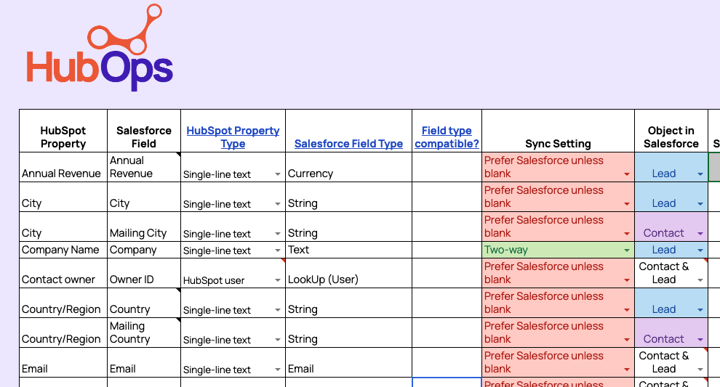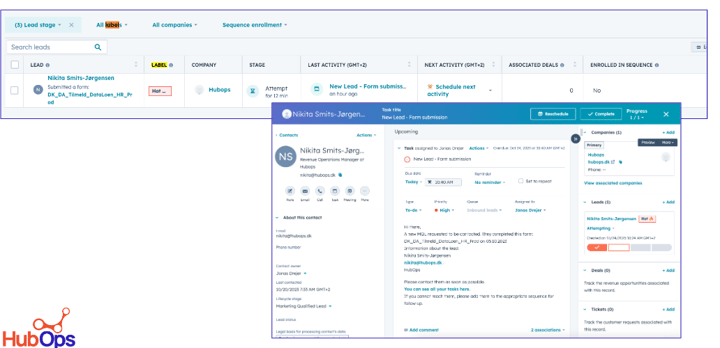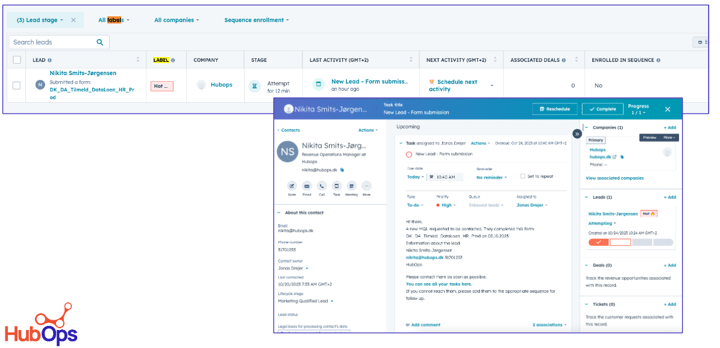HubSpot and Salesforce integration: No Salesforce Lead object
I was asked recently if I could help out with a HubSpot Salesforce integration project. The company is quite new, they started with their Marketing and sales teams in HubSpot but since have implemented a straightforward Salesforce setup albeit with interesting customer journeys and categories. The question is: "We have a small team and want to keep our setup as straightforward as possible. Do you have any suggestions? I'm sure you've written a blog on this topic so feel free to share".
One solution to the issue with duplicates is to skip the lead object in Salesforce altogether.
When I suggested this to the Sales Operations Manager who asked for integration support, I got a few follow-up questions.
-
What are the main pains that the lead object causes when integrating with HS?
-
How do you track lifecycle, opp conversions, lead gen and other early funnel metrics in SF without the Lead object and without needing mountains of customization?
The issues with using the lead object in Salesforce
This got me thinking about the biggest challenges in setting up but mostly in maintaining an integration between HubSpot and Salesforce: Sync errors. (queue suspenseful music..) Most errors are easy enough to resolve and usually expose underlying issues in your setup which should be fixed. However, duplicates and overall data hygiene are often the biggest issues and it's the hardest to clean up. The problem tends to start small but builds over time and eventually, you need a coordinated group effort to clean this up. In all my years working in Operations, this has only happened successfully once and it was a long, tedious process with a lot of hands on deck. In most cases you have to live at least with some sort of mess you won't be able to sort through, this of course creates the risk of dropped leads and missed opportunities or in the best case, a Sales team with a very long response time.
Prospecting in HubSpot
What does that look like? There are a few options. One: Prospect in HubSpot using HubSpot's lead object.
Option two: Sync your HubSpot Contacts to Salesforce as Contacts and create an opportunity for your early qualifications. This is not my preferred option as you might have various sources of leads and want to combine inbound and outbound prospecting.
A final option would be to use a third-party prospecting tool for early Sales qualification. For obvious reasons, this would never be my preferred option. More tools, more problems.
In this blog I'll explore the first option.
The Lead is dead, long live the Lead
When Salesforce introduced the Leads object, it aimed to distinguish it as a record for individuals who lacked sufficient information to be classified as contacts. What often happens though, is that the Leads object becomes a dumping ground for low-quality leads either imported or manually created. When a marketing system is connected to Salesforce, contacts generated there will also be added to Salesforce as Leads because Sales need to validate them before we know if they are 'good enough' to be added to Salesforce. Nothing wrong with with, leads get worked and converted and an Opportunity is created.
What often happens is this: All the leads that aren't ready to buy just yet, the ones you can't reach or other data that's not quite ready to be deleted stay put and over time your duplicates start to accumulate. If you have HubSpot and Salesforce integrated and the integration detects a potential duplicate, your contact from HubSpot will not sync anymore as it cannot determine whether the Lead from 5 years ago is the correct record, the imported email address with no company information or the Contact with a closed lost Opportunity from last month. When a rep wants to follow up with this person but isn't sure either, they'll create a fourth record manually, with no source information and little context so the problem only grows.
The Lead object in HubSpot works differently. It's not a precursor to a contact, it's instead a record of the interest your contact expresses in your company, for example, a demo request or an indication that your team would like to reach out to this person. Your reps have a record of every engagement which gives you more context than just the lifecycle stage or even a lead status.

A high-level overview of the new process
When integrating HubSpot and Salesforce, with prospecting in HubSpot and Opportunity management in Salesforce, this is what the setup could look like.
- All net new contacts get added to HubSpot either through forms, manual creation or uploads.
- You have clear guidelines to set sources to distinguish between inbound and outbound leads to help you attribute eventual closed won revenue.
- Determine when your contacts get synced to Salesforce. This can be done based on 'information known' such as email address and phone number or lifecycle stage and lead status.
- When an inbound lead reaches the 'MQL' lifecycle stage, you automatically create a Lead object and assign the Lead to the correct rep for follow-up. For reporting purposes this could be a good moment to sync the record to Salesforce
- The first step should be to identify, qualify and associate the correct account to the contact.
- If you have done your homework on your Total Addressable Market you can make an effort to associate your existing contacts and accounts in HubSpot or Salesforce and these get taken into consideration during the sync.
- If you don't have a TAM list yet, this is the point you might want to see if you can enrich the contact information with company information through a data provider.
- The contact gets qualified and contacted.
- If the information required to create an Opportunity is known, the rep creates an opportunity in either system.
- The Opportunity gets worked in Salesforce.
- Regardless of where the opportunity gets created, I like syncing my Salesforce opportunities back to HubSpot so Marketing can use this information to report on the success of their campaigns.
Considerations:
- Unless your market is very small and you work with small companies, you'll want to turn off 'automatic company creation' in your HubSpot settings to avoid creating duplicate companies.
- A person can move up and down your funnel and reach a certain lifecycle stage multiple times. HubSpot timestamps your lifecycle stage changes automatically. These fields can be synced to Salesforce for reporting.
Leveraging the lifecycle stage field for better funnel management
The lifecycle stage property can be a valuable tool for better funnel management. By utilizing this field, you can track leads in the early stages of the sales process and gain insights into their progression. This field can be synced with Salesforce, allowing for seamless integration between the two platforms.
These are the lifecycle stages I often end up using:
- Subscriber - Subscribed to blog
- Lead - Content download
- MQL - The Marketing Automation platform tells you the contact is ready to be sent to sales
- SAL - Sales accepts the lead (doesn’t unqualify before talking to them based on size and industry for example)
- SQL - Sales has had a conversation and has enough information to schedule a demo
- Opportunity - Deal defined (BANT or MEDDIC)
- Customer - Contact Signed
To make the most of the lifecycle stage field, consider customizing it to align with your specific sales process and funnel stages. This customization can help you effectively track and analyze the progress of leads, identify bottlenecks, and make data-driven decisions to improve your sales performance.
Lifecycle should be synced bi-directionally and you should create clear guidelines on what each stage means and what the exact triggers are to move a contact to a new lifecycle. You'll also want to think about what happens to an Account or Company when a contact gets the lifecycle stage 'Opportunity' or 'Customer. Does every contact linked to this account get the same lifecycle? Or are there other considerations to make here?
Next up: Lead status to track your engagement with a contact in your database
We like to use Lead status to indicate how a lead is engaging with us. The best part is that some of the updates to this property are automatic based on calls, emails or deals created.
- New: either the company indicated them as a lead to be worked or the lead raised their hand through a form request.
- Attempting: you’ve logged a call or you send an email.
- Connected: phone call answered or email replied to.
- Qualified: you’re creating a deal.
- Disqualified: disqualified to buy or not ready to buy, add a reason.
It's worth spending some time considering your not ready and unqualified reasons. By creating a list your team will use you'll end up with data you can report on. If you offer an 'other' option I'd enforce a field with an explanation that I'd review regularly and update my list of options if I see recurring explanations for 'other'.
Not ready reasons
- No time
- No budget
- Unreachable
- Other (comment required)
Unqualified reasons
- Wrong industry
- Too small
- No decision maker (Contact)
- Fake lead
- Incorrect data
- Partner
- Competitor
- Other (comment required)
When there is an open or a previous lead, I like to update the 'lead status' on the contact and sync this field to Salesforce for reporting purposes.
Tracking your early funnel in Salesforce
Keeping track of your early funnel for reporting purposes in Salesforce should be straightforward enough when you combine the data from these fields:
- Source: Was this an inbound or outbound lead?
- Lifecycle stage and related timestamps. How long does it take you to convert a net net inbound lead to an opportunity? What is your conversion rate on completely cold outreach?
- Lead status: What is the current state of your database? How has the volume of qualified leads changed over time?
Mapping HubSpot properties to Salesforce fields
When you're mapping you have 4 options when choosing how the values get synced:
- Prefer Salesforce unless blank: This sync setting will only update the field in Salesforce from HubSpot if there is no value for the field in Salesforce. But, once the field has been set the first time, HubSpot can not edit it anymore. It’s really important that you look at the fields that are preferring Salesforce. If you are using a lead status field or the lifecycle stage properties and this setting is enabled, HubSpot will not be able to update the value for this property.
- Always use Salesforce: This sync setting means that, regardless of if the property is blank or not, you don’t want HubSpot to update this field. That means that only Salesforce can put new data in this field and HubSpot can not change it.
- Two way sync: This is the best sync setting for most fields because HubSpot and Salesforce can update it. It will always have the most recent value.
- Don’t sync: Use this if you do not want the data on this field to be shared between HubSpot and Salesforce. If it is a default field where you can’t delete the mapping, you can click edit mapping and select don’t sync. Then, this field will not sync. You will not be able to delete the mapping, because it is a standard mapping, but you can choose not to sync it.
Before turning on your sync you might have to clean up your properties in HubSpot in order for them to play nicely with your Salesforce fields. These are the compatible types:
| HubSpot property field type | Salesforce field type |
| Dropdown select/Radio select |
picklist, reference |
| Multiple checkboxes | multi picklist |
| Single checkbox | boolean |
| Number | double/int |
| Single-line text | string, textarea |
| Multi-line text | textarea |
| Date picker | date, DateTime |
Options for tracking opportunity conversions
When it comes to tracking opportunity conversions, there are a couple of options to consider. One approach is to sync opportunities back into HubSpot and set associated contacts to the opportunity lifecycle stage. This allows for easy tracking and management of opportunities within HubSpot.
Alternatively, you can make the lifecycle stage field sync bi-directional between HubSpot and Salesforce. In this setup, the lifecycle stage is set to 'opportunity' in Salesforce when a lead is converted. This ensures that both platforms are kept up-to-date with the latest conversion status.
Choose the option that best aligns with your sales process and provides the necessary visibility and control over opportunity conversions.
Managing this change
Even though this approach might be a simplification of a slightly convoluted process, change is never easy. However, anything worth having is rarely easy to achieve. Implementing a new approach to prospecting requires change management and resources. The benefits will be worthwhile, but certain preparations need to be made beforehand.
1. Obtain Buy-In: Gain agreement from sales, marketing, account management, and executive leadership. Consider involving an expert to convince stakeholders.
2. Change Management: Plan for change, avoid last-minute communication, provide a demo, listen to frontline teams' input, and proactively address potential pitfalls.
3. Solution Design: Collaborate with an expert to migrate lead intake and handle historical data in the new process.
4. Train, Implement, and Iterate: Follow through with implementation, which typically takes 1-4 months depending on team size, data volume, and process complexity. Engage in a debate to address any concerns.
How about you? Is it time to review your HubSpot & Salesforce setup? Feel free to book a time on my calendar for a chat!






